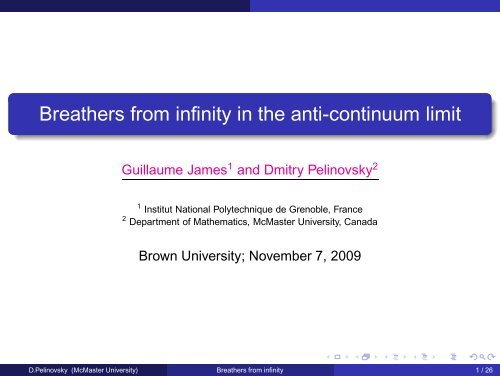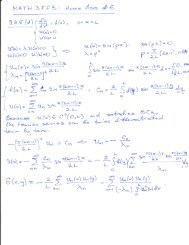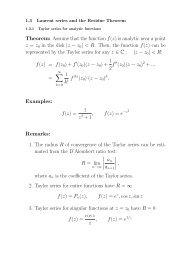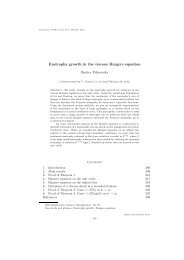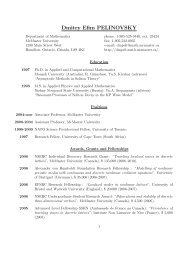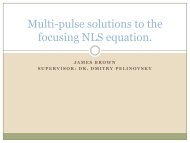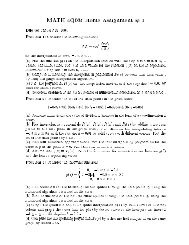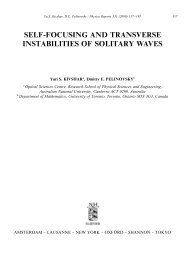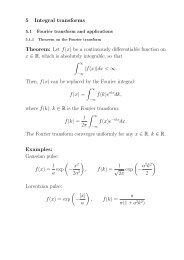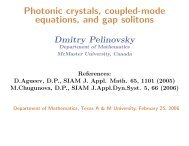Breathers from infinity in the anti-continuum limit - Dmitry Pelinovsky
Breathers from infinity in the anti-continuum limit - Dmitry Pelinovsky
Breathers from infinity in the anti-continuum limit - Dmitry Pelinovsky
Create successful ePaper yourself
Turn your PDF publications into a flip-book with our unique Google optimized e-Paper software.
<strong>Brea<strong>the</strong>rs</strong> <strong>from</strong> <strong><strong>in</strong>f<strong>in</strong>ity</strong> <strong>in</strong> <strong>the</strong> <strong>anti</strong>-cont<strong>in</strong>uum <strong>limit</strong>Guillaume James 1 and <strong>Dmitry</strong> Pel<strong>in</strong>ovsky 21 Institut National Polytechnique de Grenoble, France2 Department of Ma<strong>the</strong>matics, McMaster University, CanadaBrown University; November 7, 2009D.Pel<strong>in</strong>ovsky (McMaster University) <strong>Brea<strong>the</strong>rs</strong> <strong>from</strong> <strong><strong>in</strong>f<strong>in</strong>ity</strong> 1 / 26
The problemThe discrete Kle<strong>in</strong>–Gordon (KG) equation <strong>in</strong> one dimension:ü n + V ′ (u n ) = γ(u n+1 − 2u n + u n−1 ), n ∈ Z,where γ > 0 is <strong>the</strong> coupl<strong>in</strong>g constant and V(u) is <strong>the</strong> nonl<strong>in</strong>ear potential s.t.P1 V(x) ∈ C 4 (R) and V(−x) = V(x) for all x ∈ R;P2 V(x) = 1 2 x 2 + O(x 4 ) as x → 0;P3 0 ≤ V(x) ≤ 1 for all x ∈ R;γ = 0 is referred to as <strong>the</strong> <strong>anti</strong>-cont<strong>in</strong>uum <strong>limit</strong> of weakly coupled oscillatorss<strong>in</strong>ce <strong>the</strong> work of MacKay-Aubry (1994).D.Pel<strong>in</strong>ovsky (McMaster University) <strong>Brea<strong>the</strong>rs</strong> <strong>from</strong> <strong><strong>in</strong>f<strong>in</strong>ity</strong> 2 / 26
Discrete brea<strong>the</strong>rsWe would like to construct solutions <strong>in</strong> spacex(t) ∈ H 2 per ((0, T); l2 (Z)),so thatx(t + T) = x(t),lim |x n(t)| = 0, t ∈ R.|n|→∞These solutions are referred to as <strong>the</strong> discrete brea<strong>the</strong>rs.Additional simplifications thanks to reversibility <strong>in</strong> t ∈ R and n ∈ Z:x n (−t) = x n (t), x −n (t) = x n (t), n ∈ Z, t ∈ R.D.Pel<strong>in</strong>ovsky (McMaster University) <strong>Brea<strong>the</strong>rs</strong> <strong>from</strong> <strong><strong>in</strong>f<strong>in</strong>ity</strong> 3 / 26
Physical contextsModel<strong>in</strong>g of DNA (M. Peyrard, 2004)Josephson junction arraysSolid state physicsD.Pel<strong>in</strong>ovsky (McMaster University) <strong>Brea<strong>the</strong>rs</strong> <strong>from</strong> <strong><strong>in</strong>f<strong>in</strong>ity</strong> 4 / 26
Numerical illustrations by A. Miroshnichenkohttp://www.mpipks-dresden.mpg.de/ andreym/dbanim/D.Pel<strong>in</strong>ovsky (McMaster University) <strong>Brea<strong>the</strong>rs</strong> <strong>from</strong> <strong><strong>in</strong>f<strong>in</strong>ity</strong> 5 / 26
Why <strong>anti</strong>-cont<strong>in</strong>uum <strong>limit</strong>?The <strong>anti</strong>-cont<strong>in</strong>uum <strong>limit</strong> <strong>in</strong> KG and NLS lattices allows ...to cont<strong>in</strong>ue uniquely solutions for small γ > 0 (MacKay-Aubry, 1994);to classify all solution branches for small γ > 0 <strong>from</strong> <strong>the</strong> <strong>limit</strong><strong>in</strong>gconfiguration for γ = 0 (Alfimov et al., 2004)to count and approximate unstable eigenvalues <strong>in</strong> <strong>the</strong> spectral stabilityproblem for small γ > 0 (Koukouloyannis, Kevrekidis, 2009)to study asymptotic stability and nonl<strong>in</strong>ear dynamics analytically (P.,Sakovich, <strong>in</strong> progress)D.Pel<strong>in</strong>ovsky (McMaster University) <strong>Brea<strong>the</strong>rs</strong> <strong>from</strong> <strong><strong>in</strong>f<strong>in</strong>ity</strong> 6 / 26
Oscillations at <strong>the</strong> central siteωLet γ = 0 and consider <strong>the</strong> simplest discrete brea<strong>the</strong>r <strong>in</strong> <strong>the</strong> formx n (t) = 0,n ∈ Z\{0}.x 0 (t) ≡ x(t) is a T -periodic classical solution ofẍ + V ′ (x) = 0 ⇒ E = 1 2ẋ 2 + V(x).V(x) = tanh 2 (x/ √ 2):211x’00.5−1−2−10 −5 0 5 10x00 5 10aD.Pel<strong>in</strong>ovsky (McMaster University) <strong>Brea<strong>the</strong>rs</strong> <strong>from</strong> <strong><strong>in</strong>f<strong>in</strong>ity</strong> 7 / 26
Small-amplitude and large-amplitude brea<strong>the</strong>rsE < 1: There exist two T -periodic even solutions x(t) ∈ Hper 2 (0, T) for T > 2π.The period T = T(E) is at least C 1 .What if E > 1?First answer: No T -periodic solutions exist at all.Second answer:ẍ 0 + V ′ (x 0 ) = 2γ(x 1 − x 0 ) ⇒ ẍ 0 + V γ(x ′ 0 ) = 2γx 1 ,where V γ (x) = V(x) + γx 2 , γ > 0.D.Pel<strong>in</strong>ovsky (McMaster University) <strong>Brea<strong>the</strong>rs</strong> <strong>from</strong> <strong><strong>in</strong>f<strong>in</strong>ity</strong> 8 / 26
Small-amplitude and large-amplitude brea<strong>the</strong>rsE < 1: There exist two T -periodic even solutions x(t) ∈ Hper 2 (0, T) for T > 2π.The period T = T(E) is at least C 1 .What if E > 1?First answer: No T -periodic solutions exist at all.Second answer:ẍ 0 + V ′ (x 0 ) = 2γ(x 1 − x 0 ) ⇒ ẍ 0 + V γ(x ′ 0 ) = 2γx 1 ,where V γ (x) = V(x) + γx 2 , γ > 0.D.Pel<strong>in</strong>ovsky (McMaster University) <strong>Brea<strong>the</strong>rs</strong> <strong>from</strong> <strong><strong>in</strong>f<strong>in</strong>ity</strong> 8 / 26
Large-amplitude brea<strong>the</strong>rs <strong>in</strong> V γ (x) = V(x) + γx 2G. James, Levitt, Ferreira (Applicable Analysis, 2009) - large-amplitudebrea<strong>the</strong>rs near large-amplitude stationary statesWe would like to prove existence of large-amplitude brea<strong>the</strong>rs far <strong>from</strong>large-amplitude stationary states.D.Pel<strong>in</strong>ovsky (McMaster University) <strong>Brea<strong>the</strong>rs</strong> <strong>from</strong> <strong><strong>in</strong>f<strong>in</strong>ity</strong> 9 / 26
Review of MacKay-Aubry <strong>the</strong>oryTheorem: Fix E < 1 and assume that T(E) ≠ 2πN and T ′ (E) ≠ 0. Thereexists a small γ 0 (E) > 0 such that for all γ ∈ (0, γ 0 ) <strong>the</strong> dKG equation has aunique solution x(t) ∈ H 2 per ((0, T); l2 (Z)) such that γ ↦→ x(t) is C 1 and∃C > 0 : ‖x − xδ 0 ‖ H 2 per≤ C|γ|.Here(δ 0 ) n ={1, n = 0,0, n ≠ 0and x(t) is a solution of ẍ + V ′ (x) = 0.Two ma<strong>in</strong> steps <strong>in</strong> <strong>the</strong> proof:No resonances at o<strong>the</strong>r sites n ≠ 0;No resonance at <strong>the</strong> central site n = 0.D.Pel<strong>in</strong>ovsky (McMaster University) <strong>Brea<strong>the</strong>rs</strong> <strong>from</strong> <strong><strong>in</strong>f<strong>in</strong>ity</strong> 10 / 26
No resonances at o<strong>the</strong>r sites n ≠ 0For n ≥ 1, we haveẍ n + x n + N(x n ) = γ(x n+1 − 2x n + x n−1 ),where N(x) = V ′ (x) − x = O(x 3 ) as x → 0.Hper(0, 2 T) is a Banach algebra with respect to multiplication. For allx ∈ B δ (Hper 2 ), <strong>the</strong>re is C(δ) > 0 such that‖N(x)‖ H 2 per≤ C(δ)‖x‖ 3 H 2 per.If l<strong>in</strong>ear operator L is <strong>in</strong>vertible and <strong>the</strong>re is C > 0 such that∀f ∈ L 2 per((0, T); l 2 (N)) : ‖L −1 f‖ H 2per≤ C‖f‖ L 2per,<strong>the</strong> Implicit Function Theorem is applied. Therefore, <strong>the</strong>re is a unique mapHper 2 (0, T) ∋ x 0 ↦→ x ∈ Hper 2 ((0, T); l2 (N)) for small γ > 0 so that for allx 0 ∈ B δ (Hper)2 ∃C(δ) > 0 : ‖x‖ H 2 per≤ C(δ)γ.D.Pel<strong>in</strong>ovsky (McMaster University) <strong>Brea<strong>the</strong>rs</strong> <strong>from</strong> <strong><strong>in</strong>f<strong>in</strong>ity</strong> 11 / 26
Invertibility of <strong>the</strong> l<strong>in</strong>ear operatorWe haveẍ n + x n − γ(x n+1 − 2x n + x n−1 ) = f n , n ≥ 1with x 0 = 0 and f ∈ L 2 per ((0, T); l2 (N)).We can use <strong>the</strong> discrete s<strong>in</strong>e-Fourier transformx n (t) =∫ π−πˆx(q, t) s<strong>in</strong>(nq)dq, n ∈ Nand <strong>the</strong> Fourier seriesˆx(q, t) = ∑ m∈Zˆx m (q)e imωt ,ω = 2πT .Then, we have(1 − m 2 ω 2 + 2γ − 2γ cos(q) ) ˆx m (q) = ˆf m (q), q ∈ [−π, π], m ∈ Z.No resonances occur if ω −1 /∈ N and γ is small.D.Pel<strong>in</strong>ovsky (McMaster University) <strong>Brea<strong>the</strong>rs</strong> <strong>from</strong> <strong><strong>in</strong>f<strong>in</strong>ity</strong> 12 / 26
No resonances at <strong>the</strong> central site n = 0For n = 0, we haveẍ 0 + V ′ (x 0 ) = 2γ(x 1 − x 0 )Let x 0 = x + u and writeL 0 u + N 0 (u) ≡ ü + V ′′ (x)u + 1 2 V ′′′ (x)u 2 + ... = 2γ(x 1 − x − u)We have L 0 ẋ = 0 but ẋ is odd. The second solution of L 0 u = 0 is even but notperiodic if T ′ (E) ≠ 0. Therefore, <strong>the</strong>re is C > 0 such that∀f ∈ L 2 per (0, T) : ‖L−10 f ‖ H 2 per≤ C‖f ‖ L 2 per.By <strong>the</strong> Implicit Function Theorem, <strong>the</strong>re is a unique mapR ∋ γ ↦→ u ∈ Hper 2 (0, T) such that∃C > 0 :‖u‖ H 2per≤ Cγ.D.Pel<strong>in</strong>ovsky (McMaster University) <strong>Brea<strong>the</strong>rs</strong> <strong>from</strong> <strong><strong>in</strong>f<strong>in</strong>ity</strong> 13 / 26
Numerical resultsG. James, Levitt, Ferreira (Applicable Analysis, 2009) - large-amplitudebrea<strong>the</strong>rs near large-amplitude stationary statesLeft: <strong>the</strong> brea<strong>the</strong>r <strong>in</strong> <strong>the</strong> non-resonance doma<strong>in</strong>;Right: <strong>the</strong> brea<strong>the</strong>r <strong>in</strong> <strong>the</strong> resonance doma<strong>in</strong>.D.Pel<strong>in</strong>ovsky (McMaster University) <strong>Brea<strong>the</strong>rs</strong> <strong>from</strong> <strong><strong>in</strong>f<strong>in</strong>ity</strong> 14 / 26
Suspense story for large-amplitude brea<strong>the</strong>rsLet us add ano<strong>the</strong>r assumption on V(x):(P4) V ′ (x) is compactly supported on [−a 0 , a 0 ] and(a) lim x→∞ V(x) = V ∞ ∈ (0, 1)(b) ∫ a 00 xV ′ (x)dx ≠ 0.Theorem: Fix E > 1. Let x(t) be a T -periodic solution of ẍ + V γ ′ (x) = 0 forsmall γ > 0. For sufficiently small γ, <strong>the</strong>re exists a T -periodic solutionx(t) ∈ Hper 1 ((0, T); l2 (Z)) of <strong>the</strong> dKG equation such that∃C > 0 :supt∈[0,T]|x 0 (t) − x(t)| ≤ Cγ −1/4 , supn≥1supt∈[0,T]|x n (t)| ≤ Cγ 1/4 .Remark: ‖x‖ L ∞ per= O(γ −1/2 ).D.Pel<strong>in</strong>ovsky (McMaster University) <strong>Brea<strong>the</strong>rs</strong> <strong>from</strong> <strong><strong>in</strong>f<strong>in</strong>ity</strong> 15 / 26
Large-amplitude long-period brea<strong>the</strong>rsFeature # 1: Large-amplitude oscillations <strong>in</strong> −a ≤ x(t) ≤ a, whereso that a = O(γ −1/2 ).E = γa 2 + V(a) ⇒ E − V ∞ ≤ γa 2 ≤ E,Feature # 2: Large period of oscillationswhereT = 2 √ ∫ a20dx√E − γx2− V(x) = 2√ 2√ γ∫ π/20dθ√1 + W(θ),∀θ ∈ (0, π/2] : W(θ) =V(a) − V(a s<strong>in</strong> θ)γa 2 cos 2 θ→ 0 as γ → 0.D.Pel<strong>in</strong>ovsky (McMaster University) <strong>Brea<strong>the</strong>rs</strong> <strong>from</strong> <strong><strong>in</strong>f<strong>in</strong>ity</strong> 16 / 26
Rescal<strong>in</strong>g transformationBy <strong>the</strong> Dom<strong>in</strong>ant Convergence Theorem, T = O(γ −1/2 ).Feature # 3: Scal<strong>in</strong>g transformation br<strong>in</strong>gs about a l<strong>in</strong>ear oscillator with as<strong>in</strong>gular nonl<strong>in</strong>ear perturbation.Letx(t) = X(τ)γ 1/2 , τ = γ1/2 t, ⇒ ‖X‖ L ∞ = O(1), T 0 = O(1).New equations <strong>in</strong> rescaled variablesẌ + 2X + γ −1/2 V ′ (γ −1/2 X) = 0 ⇒ E = 1 2Ẋ2 + X 2 + V(γ −1/2 X).Therefore, ‖X‖ H 1 per= O(1) as γ → 0, whereas ‖X‖ H 2 per→ ∞.D.Pel<strong>in</strong>ovsky (McMaster University) <strong>Brea<strong>the</strong>rs</strong> <strong>from</strong> <strong><strong>in</strong>f<strong>in</strong>ity</strong> 17 / 26
No resonance with o<strong>the</strong>r sitesFeature # 4: Proximity of resonances with o<strong>the</strong>r sites.For n ≥ 1, we have two systemsandn ≥ 2 : γẌn + X n + N(X n ) = γ(X n+1 − 2X n + X n−1 )n = 1 : γẌ1 + X 1 + N(X 1 ) = γ(X 2 − 2X 1 ) + γ 1/2 X 0 ,where N(X) = V ′ (X) − X = O(X 3 ) as X → 0.Us<strong>in</strong>g <strong>the</strong> same Fourier transforms for <strong>the</strong> l<strong>in</strong>ear part, we have(1 − γm 2 ω 2 0 + 2γ − 2γ cos(q) ) ˆXm (q) = ˆF m (q), q ∈ [−π, π], m ∈ Z,where ω = ω 0 γ 1/2 is <strong>the</strong> brea<strong>the</strong>r frequency (ω 0 ∼ √ 2) and <strong>the</strong> phononfrequencies lie <strong>in</strong> <strong>the</strong> <strong>in</strong>tervals√1 1 + 4γm ≤ ω ≤ m .D.Pel<strong>in</strong>ovsky (McMaster University) <strong>Brea<strong>the</strong>rs</strong> <strong>from</strong> <strong><strong>in</strong>f<strong>in</strong>ity</strong> 18 / 26
No resonance with o<strong>the</strong>r sites1.10.9ω 0γ 1/20.70.50.30.10 0.2 0.4 0.6 0.8γ1No resonances occur <strong>in</strong> <strong>the</strong> disjo<strong>in</strong>t setC ω0 = ∪ m≥m0 (Γ m , γ m ), Γ m =κ 2ω 2 0 (m + 1)2 − 4 , γ m = κ2ω 2 0 m2.D.Pel<strong>in</strong>ovsky (McMaster University) <strong>Brea<strong>the</strong>rs</strong> <strong>from</strong> <strong><strong>in</strong>f<strong>in</strong>ity</strong> 19 / 26
No resonance with o<strong>the</strong>r sitesFix δ ∈ (0, 1) and let ˜C ω0 ,δ = ∪ m≥m0 (˜Γ m , ˜γ m ) ⊂ C ω0 with˜Γ m =κ 2ω 2 0 ((m + 1)2 − δ(m + 1)) − 4 , ˜γ m =κ 2ω 2 0 (m2 + δm) .For any γ ∈ ˜C ω0 ,δ, we have∃C > 0 : ∀f ∈ L 2 per ((0, T); l2 (N)) : ‖L −1 f‖ L 2 per≤ Cγ −1/2 ‖f‖ L 2 per,Back to equationn = 1 : γẌ1 + X 1 + N(X 1 ) = γ(X 2 − 2X 1 ) + γ 1/2 X 0 ,No fixed-po<strong>in</strong>t iterations are possible as ‖X 0 ‖ H 1 per= O(1)!..D.Pel<strong>in</strong>ovsky (McMaster University) <strong>Brea<strong>the</strong>rs</strong> <strong>from</strong> <strong><strong>in</strong>f<strong>in</strong>ity</strong> 20 / 26
Normal form transformationFeature # 5: Normal form transformationX 1 = Y 1 + γ 1/2 X 0 , X n = Y n , n ≥ 2.Then,n = 1 : γŸ1 + Y 1 + N(Y 1 + γ 1/2 X 0 ) = γ(Y 2 − 2Y 1 ) − γ 3/2 (Ẍ0 + 2X 0 ).Question: What do we know about ‖Ẍ0 + 2X 0 ‖ H 1 per?D.Pel<strong>in</strong>ovsky (McMaster University) <strong>Brea<strong>the</strong>rs</strong> <strong>from</strong> <strong><strong>in</strong>f<strong>in</strong>ity</strong> 21 / 26
Bounds on Ẍ0 + 2X 0Let X 0 satisfyẌ 0 + 2X 0 + γ −1/2 V ′ (γ −1/2 X 0 ) = 0.Thanks to <strong>the</strong> compact support of V ′ (x) on [−a 0 , a 0 ], we have |X(τ)| ≤ a 0 γ 1/2for time <strong>in</strong>terval |∆T 0 | = O(γ 1/2 ) as γ → 0. As a result, we haveFeature # 6: growth of ‖Ẍ0 + 2X 0 ‖ H 1 per:∫ T0∫ T0|Ẍ0 + 2X 0 | 2 dτ = γ −1 |V ′ (γ −1/2 X(τ))| 2 dτ ≤ C 1 γ −1/2 ,00∫ T0|(Ẍ0 + 2X 0 ) ′ | 2 dτ = γ −2 ∫ T000|Ẋ(τ)|2 |V ′′ (γ −1/2 X(τ))| 2 dτ ≤ C 2 γ −3/2 .Therefore,∃C > 0 : ‖Ẍ0 + 2X 0 ‖ H 1 per≤ Cγ −3/4 .D.Pel<strong>in</strong>ovsky (McMaster University) <strong>Brea<strong>the</strong>rs</strong> <strong>from</strong> <strong><strong>in</strong>f<strong>in</strong>ity</strong> 22 / 26
No resonance at <strong>the</strong> central site n = 0Back to equationn = 1 : γŸ1 + Y 1 + N(Y 1 + γ 1/2 X 0 ) = γ(Y 2 − 2Y 1 ) − γ 3/2 (Ẍ0 + 2X 0 ).Fixed-po<strong>in</strong>t arguments now give∃C > 0 : ∀X 0 ∈ Hper(0, 1 T 0 ) : ‖Y 1 ‖ H 1per≤ Cγ 1/4 ‖X 0 ‖ H 1per.At <strong>the</strong> central site n = 0, we haven = 0 : Ẍ 0 + 2X 0 + γ −1/2 V ′ (γ −1/2 X 0 ) = 2γ 1/2 Y 1 + 2γX 0 .Feature # 7: almost harmonic oscillationsT 0 = √ (2π 1 −Butγ 1/2π(E − V ∞ ) 3/2 ∫ a00)xV ′ (x)dx + o(γ 1/2 ) .V ′ (γ −1/2 X 0 ) = V ′ (γ −1/2 X) + γ −1/2 V ′′ (γ −1/2 X)(X 0 − X) + ...and <strong>the</strong> nonl<strong>in</strong>ear terms become too big for fixed-po<strong>in</strong>t arguments!..D.Pel<strong>in</strong>ovsky (McMaster University) <strong>Brea<strong>the</strong>rs</strong> <strong>from</strong> <strong><strong>in</strong>f<strong>in</strong>ity</strong> 23 / 26
No resonance at <strong>the</strong> central site n = 0Let us use <strong>the</strong> Fourier cos<strong>in</strong>e-series∀F ∈ L 2 per (0, T 0) : F(τ) = ∑F m cos(mω 0 τ),m∈Noddω 0 = 2πT 0.and consider <strong>the</strong> nonl<strong>in</strong>ear equation¨Z(τ) + 2Z(τ) + γ −1/2 V ′ (γ −1/2 Z(τ)) = γ 1/2 F(τ),Then, we have(2 − m 2 ω 2 0)Z m + W m (Z) = γ 1/2 F m , m ∈ N,whereW m (Z) =2T 0 γ 1/2 ∫ T00V ′ (γ −1/2 Z(τ)) cos(mω 0 τ)dτ.D.Pel<strong>in</strong>ovsky (McMaster University) <strong>Brea<strong>the</strong>rs</strong> <strong>from</strong> <strong><strong>in</strong>f<strong>in</strong>ity</strong> 24 / 26
No resonance at <strong>the</strong> central site n = 0Thanks to <strong>the</strong> compact support of V ′ (x) on [−a 0 , a 0 ], we have∃C > 0 : ∀Z ∈ H 1 per (0, T 0) : |W m (Z)| ≤ Cmγ 1/2 , m ∈ N odd,The vector Z = (Z 1 , Z 3 , Z 5 , ...) is split <strong>in</strong>to two parts Z 1 and ˜Z = (Z 3 , Z 5 , ...).Then, we have a cont<strong>in</strong>uous map R ∋ Z 1 ↦→ ˜Z ∈ l 2 (N) such that∃C > 0 : ∀Z 1 ∈ R : ‖˜Z‖ l ∞1+ ‖˜Z‖ l 2 ≤ Cγ 1/2 (1 + ‖F‖ l 2).We need ˜Z ∈ l1 2 (Z) to control˜Z(τ) = ∑ m≥3Z m cos(mω 0 τ)!D.Pel<strong>in</strong>ovsky (McMaster University) <strong>Brea<strong>the</strong>rs</strong> <strong>from</strong> <strong><strong>in</strong>f<strong>in</strong>ity</strong> 25 / 26
F<strong>in</strong>al step - projection to Z 1Elim<strong>in</strong>at<strong>in</strong>g ˜Z , we obta<strong>in</strong>(2 − ω 2 0 )Z 1 + γ1/2πZ 2 1∫ a00xV ′ (x)(1 − γx2 ) dx = Z 1/2 γ1/2 F 1 .12By <strong>the</strong> Implicit Function Theorem, this gives∃C > 0 : |Z 1 − (E − V ∞ ) 1/2 | ≤ C‖F‖ L 2 small.By fixed-po<strong>in</strong>t iterations, this construction f<strong>in</strong>ally gives‖X 0 − X‖ H 1 per≤ Cγ 1/4 .D.Pel<strong>in</strong>ovsky (McMaster University) <strong>Brea<strong>the</strong>rs</strong> <strong>from</strong> <strong><strong>in</strong>f<strong>in</strong>ity</strong> 26 / 26


